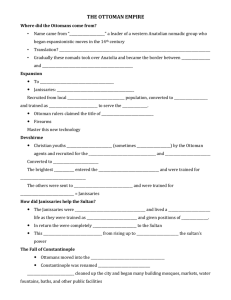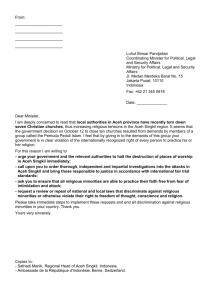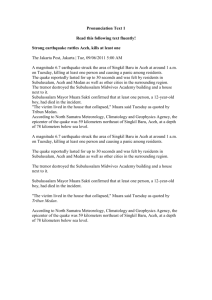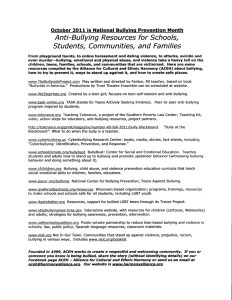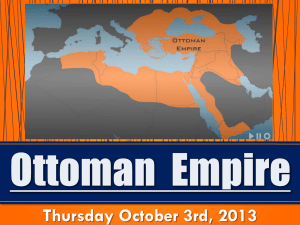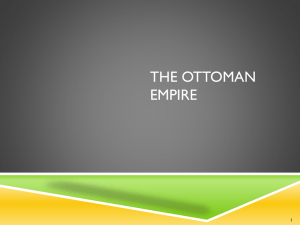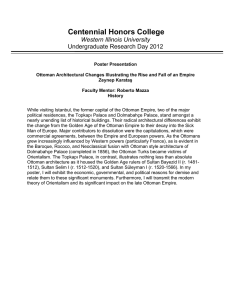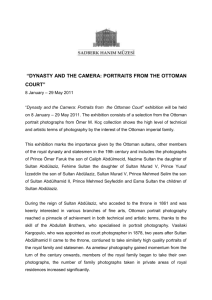Bustan al-Salatin Mediterranean Journal of Social Sciences Ermy Azziaty Rozali MCSER Publishing, Rome-Italy
advertisement
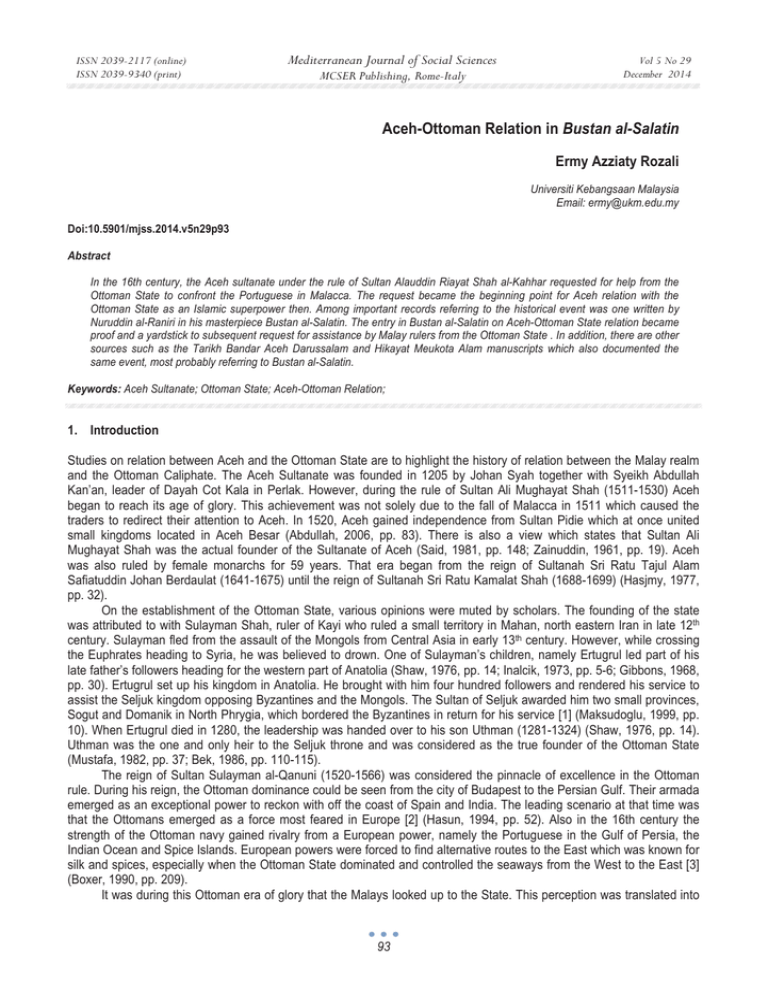
ISSN 2039-2117 (online) ISSN 2039-9340 (print) Mediterranean Journal of Social Sciences MCSER Publishing, Rome-Italy Vol 5 No 29 December 2014 Aceh-Ottoman Relation in Bustan al-Salatin Ermy Azziaty Rozali Universiti Kebangsaan Malaysia Email: ermy@ukm.edu.my Doi:10.5901/mjss.2014.v5n29p93 Abstract In the 16th century, the Aceh sultanate under the rule of Sultan Alauddin Riayat Shah al-Kahhar requested for help from the Ottoman State to confront the Portuguese in Malacca. The request became the beginning point for Aceh relation with the Ottoman State as an Islamic superpower then. Among important records referring to the historical event was one written by Nuruddin al-Raniri in his masterpiece Bustan al-Salatin. The entry in Bustan al-Salatin on Aceh-Ottoman State relation became proof and a yardstick to subsequent request for assistance by Malay rulers from the Ottoman State . In addition, there are other sources such as the Tarikh Bandar Aceh Darussalam and Hikayat Meukota Alam manuscripts which also documented the same event, most probably referring to Bustan al-Salatin. Keywords: Aceh Sultanate; Ottoman State; Aceh-Ottoman Relation; 1. Introduction Studies on relation between Aceh and the Ottoman State are to highlight the history of relation between the Malay realm and the Ottoman Caliphate. The Aceh Sultanate was founded in 1205 by Johan Syah together with Syeikh Abdullah Kan’an, leader of Dayah Cot Kala in Perlak. However, during the rule of Sultan Ali Mughayat Shah (1511-1530) Aceh began to reach its age of glory. This achievement was not solely due to the fall of Malacca in 1511 which caused the traders to redirect their attention to Aceh. In 1520, Aceh gained independence from Sultan Pidie which at once united small kingdoms located in Aceh Besar (Abdullah, 2006, pp. 83). There is also a view which states that Sultan Ali Mughayat Shah was the actual founder of the Sultanate of Aceh (Said, 1981, pp. 148; Zainuddin, 1961, pp. 19). Aceh was also ruled by female monarchs for 59 years. That era began from the reign of Sultanah Sri Ratu Tajul Alam Safiatuddin Johan Berdaulat (1641-1675) until the reign of Sultanah Sri Ratu Kamalat Shah (1688-1699) (Hasjmy, 1977, pp. 32). On the establishment of the Ottoman State, various opinions were muted by scholars. The founding of the state was attributed to with Sulayman Shah, ruler of Kayi who ruled a small territory in Mahan, north eastern Iran in late 12th century. Sulayman fled from the assault of the Mongols from Central Asia in early 13th century. However, while crossing the Euphrates heading to Syria, he was believed to drown. One of Sulayman’s children, namely Ertugrul led part of his late father’s followers heading for the western part of Anatolia (Shaw, 1976, pp. 14; Inalcik, 1973, pp. 5-6; Gibbons, 1968, pp. 30). Ertugrul set up his kingdom in Anatolia. He brought with him four hundred followers and rendered his service to assist the Seljuk kingdom opposing Byzantines and the Mongols. The Sultan of Seljuk awarded him two small provinces, Sogut and Domanik in North Phrygia, which bordered the Byzantines in return for his service [1] (Maksudoglu, 1999, pp. 10). When Ertugrul died in 1280, the leadership was handed over to his son Uthman (1281-1324) (Shaw, 1976, pp. 14). Uthman was the one and only heir to the Seljuk throne and was considered as the true founder of the Ottoman State (Mustafa, 1982, pp. 37; Bek, 1986, pp. 110-115). The reign of Sultan Sulayman al-Qanuni (1520-1566) was considered the pinnacle of excellence in the Ottoman rule. During his reign, the Ottoman dominance could be seen from the city of Budapest to the Persian Gulf. Their armada emerged as an exceptional power to reckon with off the coast of Spain and India. The leading scenario at that time was that the Ottomans emerged as a force most feared in Europe [2] (Hasun, 1994, pp. 52). Also in the 16th century the strength of the Ottoman navy gained rivalry from a European power, namely the Portuguese in the Gulf of Persia, the Indian Ocean and Spice Islands. European powers were forced to find alternative routes to the East which was known for silk and spices, especially when the Ottoman State dominated and controlled the seaways from the West to the East [3] (Boxer, 1990, pp. 209). It was during this Ottoman era of glory that the Malays looked up to the State. This perception was translated into 93 ISSN 2039-2117 (online) ISSN 2039-9340 (print) Mediterranean Journal of Social Sciences MCSER Publishing, Rome-Italy Vol 5 No 29 December 2014 sending an envoy to request for help. Aceh under the rule of Sultan Alauddin Riayat Shah al-Kahhar sent an envoy to the Ottoman Caliphate to ‘strengthen the religion of Islam’ (al-Raniri, Undated, pp. 282-283). Arrival of the Turks with armaments to Aceh enabled Sultan Alauddin Riayat Shah al-Kahhar to defeat the Bataks and seize Aru in North Sumatera. Ottoman later on gained special trading privilege at the port of Pasai. The military assistance consisted of sixty Turkmen, forty janissary soldiers and the Moors from Malabar [4] (Reid, 1969, pp. 402; Anon, 1993, pp. 146; Anon, 2005a, pp. 77; Said, 1981, pp. 185). Aceh-Ottoman relation in this article referred to the book Bustan al-Salatin, a piece by Syeikh Nuruddin al-Raniri. In Bustan al-Salatin it was recorded that his name was Nuruddin bin Ali bin Hasanji bin Muhammad Hamid, born in Ranir, India and came to Aceh on the 6th of Muharram 1040H (15 August 1630AD). On the 17th of Shawwal 1040H, Sultan Iskandar Thani ordered him to write a book which would contain information on the dwellers of the sky and the earth, history of the sultanate and their rule [5] (al-Hasani, 1976, pp. 360). Information on the early life history of al-Raniri is incomplete, particularly on his educational background. He got his education in his own village in Ranir. There, he learnt religious disciplines, specifically in Shafi’i mazhab. Al-Raniri then furthered his studies in Tarim, south Arabia which was then a centre of knowledge excellence. In 1612 he went to Mecca and Medina to perform haj. While he was in Mecca, al-Raniri made many contacts with Javanese. One of his teachers was Sheikh Abdul Rauf Fansuri [6] (Abd Rahman, 2006, pp. 4-8). Al-Raniri was a sheikh in tasawuf tarekat which was received from his teacher Sayyid Umar bin Abdullah Ba’ Syaiban. He followed the footsteps of his uncle, Muhammad Jailani bin Hassan al-Raniri, who visited Aceh on Sunday 31st of May 1637 [7] (Iskandar, 1966, pp. 3; al-Attas, 1966, pp. 12-14). The role played by al-Raniri was to teach religious knowledge in Aceh. Among the subjects taught by him were Arabic grammar, usooluddin, fiqh, tasawuf, exegesis, hadith, mantiq, ilmu ma’ani, bayan, falak and history. Many students from outside came to Aceh to obtain the knowledge from him (Abd. Rahman Jamalullail, Undated, pp. 9). Al-Raniri’s inclination to come to Aceh at that time was due to fact that Aceh was a focal point for traders, ulema and literary coterie. The fall of the Malaccan Sultanate to the Portuguese in 1511 caused the groups of people to cross the Straits of Malacca and shifted their attention to Aceh in North Sumatera. Nevertheless, the first arrival of al-Raniri was unsuccessful because of his conflict with Hamzah Fansuri and Shamsuddin al-Sumatrani. Both figures were then advisors to Sultan Iskandar Muda. Therefore, al-Raniri went to Malay Peninsula (Iskandar, 1964, pp. 436-437). While in Malay Peninsula, al-Raniri resided in Pahang and became acquainted with Iskandar Thani, a Pahang royal prince. When Iskandar Thani became the ruler of Aceh, al-Raniri replaced Shamsuddin al-Sumatrani as Aceh ulama and royal scribe [8] (Hashim, 1988, pp. 245; Iskandar, 1966, pp. 3). In Aceh al-Raniri succeeded in holding important position at the palace as the mufti to Sultan Iskandar Thani and that gave him opportunity to forge a very close relation with the sultan. Sultan Iskandar Thani later on entrusted him with the duty of writing the genealogy of Aceh rulers, as recorded in the early section of Bustan al-Salatin (Harun, 2004, pp. xxxviii). 2. A Cursory Review of Bustan al-Salatin Bustan al-Salatin is a magnum opus of al-Raniri [9] (Undated, pp. 4). This book is an amalgamation of several Arabic writing such as ’Ajaib al-Malakut, Daqaiq al-Haqaiq and Mirsad al-‘Ibad. In addition, he also quoted from exegesis books such as Mu’allim al-Tanzil, Raudah al-Riyahin and Turhatu al-Akhbar fi Mahasin al-Akhbar. Using these sources and supported by al-Quran and sahih hadeeth at the end of each written story, the book was named Bustan al-Salatin fi Dhikir al-Awwalin wa al-Akhirin (al-Raniri, Undated, pp. 5). Further to combination of Arabic and Persian sources, al-Raniri also included the history of the sultanates of Aceh, Pahang, Perak and Malacca [10] (al-Raniri, Undated, pp. 282-289). Bustan al-Salatin was written on the order of Sultan Iskandar Thani and the book on the whole contained seven chapters and specific articles. The chapters consisted of the first which tells about the creation of the seven layers of the sky and earth (10 articles), the second on all prophets and all the kings (13 articles), the third on all the just rulers and ministers (6 articles), the fourth on all hermit kings and all pious prophets (2 articles), the fifth on the actions of unjust rulers and despotic ministers (2 articles), the sixth on all people of generosity and courage (2 articles) and finally the seventh on the mind and knowledge, instinct, diseases and medicinal knowledge, as well as female nature and magical tales (5 articles) (al-Raniri, Undated, pp. 5; Harun, 2003, pp. 54). In addition, historical elements in classical Malay literatures were also found in Bustan al-Salatin which had close links with the concepts of world history and Islamic histiography. The history in Bustan al-Salatin is not only made up of factual events but also mythological and theological historical elements. Understanding the meanings of history in this book cannot be reached based solely on factual evidence “cause and effect” logic which underlines modern history disciplines, but it must be read and interpreted based on meanings and its specific methodology beginning from Islamic histiographical concepts which have been long in existence in Islamic scholastic tradition (Harun, 2004, pp. xxxvi). 94 ISSN 2039-2117 (online) ISSN 2039-9340 (print) Mediterranean Journal of Social Sciences MCSER Publishing, Rome-Italy Vol 5 No 29 December 2014 3. Aceh-Ottoman Relation in Bustan al-Salatin Relation between the Malay World and the Ottoman State can be seen in Bustan al-Salatin in the Second Chapter, 11th Article (http://www.ari.nus.edu.sg/docs/wps/wps05_036.pdf): Kemudian dari itu maka Kerajaan Sultan Alau’di-Din Ri‘ayat Shah ibn Sultan ‘Ali Mughayat Shah, pada hari Isnin waktu Dhuha 20 bulan Dzulkaedah ialah yang mengadatkan segala istiadat kerajaan Aceh Daru’s salam dan menyuruh utusan kepada Sultan Rum, ke negeri Istambul kerana meneguhkan agama Islam. Maka dikirim Sultan Rum daripada segala jenis-jenis utus dan pandai yang tahu menuang bedil. Maka pada zaman itulah dituang orang meriam yang besar2. Dan ialah yang pertama berbuat kota di negeri-negeri Aceh Daru’ssalam, dan ialah yang pertama2 ghazi dengan segala kafir sehingga sendirinya berangkat menyerang Melaka (al-Raniri, Undated, pp. 283-284). He [Sultan Alau’d-Din Ri’ayat Shah al-Kahar] it was who created the system of government of Aceh Daru’s-Salam and sent a mission to Sultan Rum, to the state of Istanbul, in order to strengthen the Muslim religion. Then Sultan Rum sent various craftsmen and experts who knew how to make guns. It was at that time that the large guns were cast. It was also he who first built a fort at Aceh Daru’s-Salam, and he who first fought all unbelievers, to the extent of going to attack Melaka in person. This al-Raniri’s entry explained that the envoy explained that the envoy sent to the Ottoman State got a reply from Sultan Salim II (1566-1574), who dispatched aids of weapon, cannon experts and skilled manpower to build forts. The cannon sent by the Ottoman Sultan was larger in size compared to the existing ones in Aceh. With that help, it enabled Sultan Alauddin Riayat Shah to depart with his army to strike the Portuguese in Malacca. The assault launched in 1568 was seen as the first launched by the Aceh sultanate. The title ‘al-Kahhar’ given to Sultan Alauddin refers to his courage and persistence opposing the Portuguese (al-Raniri, Undated, pp. 283-284; Said, 1981, pp. 198). The attack by Sultan Alauddin al-Kahhar in 1568 was among the large assault launched by Aceh against the Portuguese (Boxer, 1969, pp. 421). The Portuguese were reported to be always wary of the relation forged by Aceh with the Ottoman State. Portuguese representative in Goa reported that in 1564, the Sultan of Aceh send an emissary to Istanbul requesting for military aid such as cannons and weapon experts. This envoy brought along gold, black peppers and spices. If the Portuguese could be repelled out of Malacca with the help of the Ottomans, the spice trade would benefit a huge gain in the region. A message was obtained from two Portuguese spies in Venice dated 27th August 1564, informing the King of Portugal of a letter received from Seignory from Cairo on the news of arrival of 1,800 quintals of black pepper and 3,000 quintals spices (Boxer, 1969, pp. 420). The goods arrived in Jeddah on 23 ships, part of which was from Aceh. The Acehnese were skilled in commodity trade and they too had sent commodities as gifts to The Sultan of Ottoman Caliphate in Istanbul. This information was also received from the Jews and the Venice envoy in Ottoman palace. The Aceh envoy had requested assistance of weapon experts. Later, six weapon experts and six military experts were dispatched to them. In return, Aceh presented Turkish dignitaries with gifts of huge necklace made of pearls, diamonds and gemstones (Boxer, 1969, pp. 420). Examination of Bustan al-Salatin also reveals that information about the reign of Sultan Alauddin Riayat Shah alKahhar only touched on the sending of envoys to Istanbul to request for help against the Portuguese and the proses of power transition to his son, namely Sultan Husin Ibn Sultan Alauddin Riayat Shah who was called Sultan Ali Riayat Shah. The focus of mentioning dispatching of the envoys to Istanbul was probably due to an awareness of Sultan Alauddin about Aceh’s limited capability to combat the Portuguese, before asking for help from the Ottoman Caliphate. Therefore, the sending of envoys to Istanbul by Sultan Alauddin became an important log in the history of Aceh (al-Raniri, Undated, 283-284; Schrieke, 1957, pp. 245; Norpriadi, 2005). Scrutiny of Turkish records showed that the envoy from Aceh arrived in Istanbul on the first occurrence in 1547. A record exists which stated that there was envoy from one ‘Alauddin a ruler of India’ who requested for help against the Portuguese. The notation ‘Alauddin a ruler from India’ refers to Sultan Alauddin Riayat Shah al-Kahhar who ruled Aceh in 1537-1571. Since documents related to Aceh is classified under India, the name Aceh in the 16th century in the Ottoman archive is called “Ashi”, “Achi” or “Achin”. In 1562, an Aceh ambassador was official sent to Istanbul to ask for help. The Sultan of Ottoman later on reciprocated by sending an envoy to Aceh in 1565 [11] (Göksoy, 2007; Yusoff, 2008, pp. 6). The Aceh-Ottoman Caliphate relation was later reinforced by sending of the next envoy to Istanbul named Husain who brought with him a letter dated 7 January 1566. This letter was classified as one of the letters in the Indian Office collection available in the Topkapi Palace Archive in Istanbul. Sultan Alauddin stated in that letter an appreciation of the previous assistance rendered by the Ottoman State and asked for a next assistance. Information on the politics and cultures of the region, threats and disturbance from the Portuguese was also told. The Portuguese captured hajj pilgrims 95 ISSN 2039-2117 (online) ISSN 2039-9340 (print) Mediterranean Journal of Social Sciences MCSER Publishing, Rome-Italy Vol 5 No 29 December 2014 and traders who were then enslaved, confiscated goods, burnt and then sank ships of the Muslims into the ocean [12] (Reid, 2005, pp. 5; Algadri, 1983, pp. 46). Apart from reporting Portuguese mischief, Sultan Alauddin also explained the situation of the Muslim community in Calicut, South India. He also told about the ruler of Sri Lanka who was not Muslim. In addition, there were fourteen mosques on that island and the congregation pray for the Ottoman Sultan in their Friday sermon. The request pleaded by Sultan Alauddin was delivery of horses, experts in cannon manufacture and experts in palace construction. His highness also hoped that the Ottoman Sultan recognise Aceh as his protectorate and Aceh people as citizens of the Ottoman State (Göksoy, 2007, pp. 7). Sultan Alauddin also requested that the governors and Ottoman officials in Hijaz, Yemen, Jeddah and Aden be informed that Aceh envoys were neither outsiders nor enemies but citizens of the Ottoman State. Sultan Alauddin was confident that the Portuguese could be defeated if the aids were sent. Even though receiving an offer of help from rulers in India and in the region, Aceh was more hopeful of getting help from the Ottoman State. Husain as the Aceh envoy arrived in Istanbul when Sultan Sulaiman al-Qanuni (1520-1566) was in a military expedition in Szigetvar, Hungary. The sudden death of Sultan Sulaiman al-Qanuni resulted in Husain having to wait for almost two years in Istanbul (Göksoy, 2007, pp. 7; Reid, 1969, pp. 404; Boxer, 1969, pp. 421; Said, 1981, pp. 188-189; Voorhoeve, 1986, pp. 143). Successor to Sultan Sulayman, namely Sultan Salim II (1566-1574) was optimistic in giving help to Aceh and continuing his father’s efforts. A fleet consisting of 15 long ships, two big ships, imperial cannon experts, soldiers from Egypt and weaponry equipment to attack the enemy was prepared. The fleet was to be headed by Admiral Kurtoglu Hezeir Reis. During the preparation, a rebellion broke out in Yemen. Sultan Salim II directed the fleet to rush to Yemen to quell the rebellion and therefore the assistance to Aceh was postponed to the following year [13] (Göksoy, 2007, pp. 7107; Reid, 1969, pp. 404; Anon, 2005b, pp. 5; Said, 1981, pp. 188-189). The rebellion in Yemen lasted until 1570 and several years had to be taken to calm the situation. There are a few opinions of scholars in summing up the sending of help to Aceh. øsmail Hakki Uzunçarsili has the opinion that there was no specific plan to send expedition to Aceh but cannon experts, weapon experts and soldiers actually meant for Aceh in two ships and the actual expedition made a detour to Yemen. Meanwhile, Saffet Bey, Ismail Hamdi, Daniúmend and Mehmed Ziya asserted that the planned expedition to Aceh proceeded and Daniúmend further explained that the dominance of the Ottoman State expanded to Asia, Europe and Africa (Göksoy, 2007, pp. 12-13). The Ottoman Ambassador to Batavia, Metin ønegöllüo÷u opined that the expedition was successfully carried out and two ships were sent to Aceh. N. Ahmet Asrar who examined Ottoman documents has the opinion that only military assistance and weapons were sent to Aceh. Anthony Reid also shared the same opinion that Kurtoglu Hizir Reis and his troop did not reach Aceh. Nevertheless, assistance of manpower, weapon, banners and imperial envoy were still dispatched. In general, the help from the Ottoman State reached Aceh in smaller quantity, unlike the original plan since the actual expedition was sent to Yemen to destroy the rebellion (Göksoy, 2007, pp. 12-13). The envoy sent by the Ottoman State consisted of five people including weapon manufacture experts. They arrived in Aceh with two ships circa 1566 or 1567. Aside from the assistance requested from the Ottoman State, Sultan Alauddin also asked for help from Calicut and Japara to launch an attack on the Portuguese in Malacca on the 16th of February 1568 (Poesponegoro & Notosusanto, 1992, pp. 54; Boxer, 1969, pp. 422). In this attack, Aceh troop consisted of 15,000 soldiers including 400 Turks and 200 copper cannons. The assault was led by Sultan Alauddin himself. The Portuguese meanwhile succeeded to get help from Goa and asked for the assistance of Kedah and Johore [14] (Said, 1981, pp. 196). The sending of envoy to Aceh by the Ottoman Sultan also helped Sultan Alauddin Riayat Shah al-Kahhar to defeat the Bataks and capture Aru in North Sumatera. Aceh continually received help from the Ottoman State and one of its war general of Ethiopian descent named Mamedecan (Mahmud Khan) came from Jeddah. Delivery of the aids followed the recognition of the Ottoman Sultan sealed between Aceh Sultan and Ottoman representative in Cairo. The Ottoman State later received special trading privilege at the port of Pasai. The assistance given was 60 Turkmen, 40 Janissary soldier and the Moors from Malabar (Reid, 2005, pp. 77; Anon, 1969, pp. 402; Said, 1981, pp. 185). Other than Bustan alSalatin, manuscript “Tarikh Sultan Aceh Bandar Darussalam dan Jajahan Takluknya” [15] (Abd. Rahman Jamalullail, Undated, pp. 1-12) also touched on the early relation between the two powers (Abd. Rahman Jamalullail, Undated, pp. 8). “Tarikh Sultan Aceh” further reinforced the relation between the ruler of Aceh and that of the Ottoman State during the reign of Sultan Alauddin al-Kahhar in the former. It is clear that the author of “Tarikh Sultan Aceh” recreated the record of the relation which was most possibly taken from Bustan al-Salatin (Abd. Rahman Jamalullail, Undated, pp. 8). The giving of military aid and manpower by the Ottoman State led to a transfer of technology in the field of defence and military. The process of weapon manufacture was learnt by the Acehnese from the Ottomans who were known to be capable of producing giant cannons. According to John Davis in his travel log, he claimed that the cannon available in 96 ISSN 2039-2117 (online) ISSN 2039-9340 (print) Mediterranean Journal of Social Sciences MCSER Publishing, Rome-Italy Vol 5 No 29 December 2014 Aceh was among the biggest he had ever witnessed. Furthermore, weapon making process also developed in West Sumatera, Bali, Java and also Sulawesi [16] (Reid, 2000, pp. 23; Schrieke, 1957, pp. 246; Abdullah, 1981, pp. 827). Cannon manufacturing industry also grew in Aceh to the extent that it succeeded to fulfil orders from outside such as Demak and also Banten (Said, 1981, pp. 194). Through the advancement in the field of defence and military at that time, the Aceh sultanate was able to expand their influence to the central region of Sumatera, including the Bataks, and consequently was successful in conquering their territory [17] (Thaib, 2002, pp. 68; Yusoff, 2008, pp. 4). The history of Aceh-Ottoman relation forged in the 16th century can be seen in the legacy of a cannon at the palace of Aceh, which was a gift from the Ottoman State, and Aceh government flag which was taken from the flag of the Ottoman State (Reid, 1969, pp. 75; Anon, 2005b, pp. 6). Based on the oral tradition of the people of Aceh, the cannon was a gift from the Ottoman Sultan in return for the sending of an envoy by the Sultan of Aceh (Hurgronje, 1906, pp. 208). This matter of envoy sending to the Ottoman State was also recorded in the tale of Hikayat Meukota Alam. In that tale, the Sultan of Aceh who was responsible for sending the envoy was Sultan Iskandar Muda Mahkota Alam and not Sultan Alauddin Riayat Shah as noted in Bustan al-Salatin. The difference in time between the two writings is almost a century. However, the tale in in Hikayat Meukota Alam was prone to oral tradition. As a conclusion, sending of the envoy was a significant event and both authors felt the need to record it in their respective work (Salleh, 1992, pp. xxxiv-xxxv). Hikayat Meukota Alam told of Sultan Iskandar Muda (1607-1636) who forged a tie with the Ottoman State. His Highness dispatched three ships loaded with pepper, rice and paddy to help the Turks guard Mecca. The convoy got lost and had to use the cargo for sustenance until only ‘secupak lada’ (a measure of pepper) was left to be presented to the Ottoman Sultan. However, the Turkish sultan felt honoured with the gift and in return reciprocated with a cannon named “Lada Secupak” complete with weaponry equipment and experts to build barricades and castles [18] (Abdullah, 1981, pp. 637-638). They were said to be from Syria and opened a settlement area named Bitay (after Bait al-Maqdis) close to the Aceh palace (Hurgronje, 1906, pp. 182). From the perspective of state security needs, dispatching of the emissary was more reasonable to occur during the time of Sultan Alauddin because at that time the Portuguese were still positioned in Malacca causing mayhem in the Malay World. On the contrary, from the angle of power, Sultan Iskandar Muda was more capable and considered himself to be at par with the Ottoman Sultan. Nevertheless, there is also the possibility that both sultans sent their respective envoys for distinctive reasons suiting the needs of that time (Said, 1981, pp. 182). In general, the history of dispatching of envoys and aids between Aceh and the Ottoman State as recorded in Bustan al-Salatin was the earliest proof which shows the relation between the Malay World and the Ottoman State in the 16th century. The inclination of subsequent literatures to repeat fragments of historical records of the relation between Aceh and Ottoman-Turkey is seen as an effort to keep the relation which became a symbol of strength for the Malay kingdom when it was associated with the Ottoman State. 4. Conclusion On the whole, it can be seen that Aceh-Ottoman relation was an important historical note recorded in Bustan al-Salatin. The relation established between the two Islamic powers with vastly different geographical factors proved the existence of cooperation in the Islamic world, especially in opposing Western colonisation. Ottoman aids to Aceh had its own significance in increasing the defence aspect of Aceh apart from highlighting the role of the Ottoman State which at that time helmed the Islamic Caliphate institution. 5. Acknowledgement This study is financed by the Research Group of Arabic Culture and Islamic Civilization (KUKAPI, DPP-2014-068), UKM; the Action/Strategic Research Project (PTS-2012-061; PTS-2014-068), UKM; the University-Industry Incentive Grant (INDUSTRI-2012-006), UKM; the Arus Perdana Project (AP-2012-001; AP-2013-017; AP-2014-006), UKM; and the Exploratory Research Grant Scheme (ERGS) of the Ministry of Education of Malaysia. Endnote [1] Sultan Alauddin (1284-1307) di Konya melantik Uthman sebagai amir (pemerintah) di Sogut dengan gelaran ‘Uthman Shah’. Sultan Alauddin juga menjelaskan bahawa kedudukan Uthman sebagai ‘Zillullah fi al-Ard’ yang bermaksud sebagai khalifah Allah di bumi ini (Maksudoglu, 1999, pp. 10). [2] Sultan Sulayman al-Qanuni dilahirkan pada tahun 1495. Baginda menggantikan ayahandanya Sultan Salim I yang mangkat ketika 97 ISSN 2039-2117 (online) ISSN 2039-9340 (print) Mediterranean Journal of Social Sciences MCSER Publishing, Rome-Italy Vol 5 No 29 December 2014 dalam perjalanan untuk menawan Constantinople. Di antara kejayan awal Sultan Sulayman ialah menawan Belgrade, Pulau Rhodes dan juga wilayah Crimea (Hasun, 1994, pp. 52; Odysseus, 1900, pp. 63). [3] Secara keseluruhannya, kepimpinan dawlah Uthmaniyah diterajui oleh 42 orang pemerintah, iaitu bermula dengan Uthman hinggalah kepada Sultan Abdul Majid II selama lebih kurang enam abad. Dawlah Uthmaniyah kemudiannya berakhir apabila Mustafa Kemal memansuhkan institusi khilafah Uthmaniyah dan menubuhkan Republik Turki pada 1924 (Boxer, 1990, pp. 209). [4] Selain Aceh, Sultan Bahadur Shah dari Gujarat, India juga menghantar utusan ke dawlah Uthmaniyah untuk memohon bantuan bagi menentang Portugis (Maksudoglu, 1999, pp. 131). Pemohonan bantuan daripada umat Islam dari sebelah Timur ini menunjukkan bahawa kedudukan dawlah Uthmaniyah ketika itu yang dianggap sebagai kuasa Islam yang terbesar dan mampu memberikan saingan kepada kuasa Barat (Reid, 1969, pp. 402; Anon, 1993, pp. 146; Anon, 2005a, pp. 77; Said, 1981, pp. 185). [5] Kota Ranir terletak di daerah Surat, Gujarat, India. Sempena mengambil nama tempat inilah beliau dikenali sebagai al-Raniri atau alRandiri (al-Raniri, undated, pp. 3-4; al-Hasani, 1976, pp. 360). [6] Al-Raniri kemudiannya kembali ke India untuk mengajar ilmu agama sebelum menuju ke Aceh. Tiada catatan mengenai anak murid beliau. Terdapat beberapa pandangan sarjana yang menyatakan bahawa Tun Seri Lanang pernah menjadi anak muridnya ketika menjadi tawanan kerajaan Aceh yang berjaya mengalahkan Johor. Begitu juga dengan Sheikh Yusuf Makassar yang dianggap pelajarnya yang paling menonjol di Alam Melayu (Abd Rahman, 2006, pp. 4-8). [7] Seorang sarjana Indonesia yang terkemuka iaitu Hoesin Djajaningrat menolak pandangan Van der Tuuk yang menyatakan Nuruddin al-Raniri menulis Bustan al-Salatin sekitar tahun 1630-1631. Ini kerana Djajaningrat berjaya membuktikan bahawa al-Raniri tiba di Aceh pada tahun 1637 dan tiada bukti yang dapat menunjukkan beliau tiba lebih awal dari tarikh tersebut (Iskandar, 1966, pp. 3; al-Attas, 1966, pp. 12-14). [8] Kehadiran al-Raniri ke Semenanjung Tanah Melayu dibuktikan dengan pengetahuan beliau mengenai sejarah Melayu yang kemudiannya dimasukkan ke dalam penulisan Bustan al-Salatin. Begitu juga dengan mengenai salsilah Pahang dan hubungan yang baik dengan Sultan Iskandar Thani (Hashim, 1988, pp. 245; Iskandar, 1966, pp. 3). [9] Bahagian mukadimah Bustan al-Salatin, al-Raniri (Undated, pp. 4) mencatatkan kitab tersebut mula ditulis pada 17 Syawal 1040 (bersamaan 4 Mac 1638). [10]Penulisan mengenai sejarah kerajaan Aceh dan kerajaan Melayu memberikan kelainan kepada Bustan al-Salatin berbanding karya sebelumnya seperti Hikayat Aceh dan Taj al-Salatin (al-Raniri, Undated, pp. 282-289). [11]Pada tahun 1561, berlaku persaingan sengit di antara Portugis dan orang Islam di Semenanjung Tanah Arab. Dua kapal Portugis memintas sebuah kapal perang besar milik orang Islam yang mempunyai 50 buah meriam dan membawa muatan wang mas untuk diserahkan kepada Sultan dawlah Uthmaniyah. Kapal tersebut dikendalikan oleh 500 orang pahlawan yang terdiri daripada bangsa Turki, Habshah dan Aceh yang berlayar dari Aceh menuju ke dawlah Uthmaniyah. Kedua-dua kapal perang Portugis berjaya dikalahkan oleh orang Islam (Göksoy, 2007, pp. 5; Yusoff, 2008, pp. 6). [12] Surat Sultan Alauddin kepada Sultan Sulaiman al-Qanuni (Ankara Üniversitesi Dil, 1967, 373-409) dan Origin of the Sultan Alaadin’s Letter, Archive of Topkapi Palace Musuem, No : E-8009 (Goksoy, 2007, pp. 6). [13] Numarali Mühimme Defteri (973-976/1567-1569) I (The Number 7 Register on Importance I (973-976/1567-1569), No : 33, Ankara : BOA Publications 1996, Origional Print : Nr : 244, p. 90-93 ;Transcription : Nr : 244, p. 124-126. See also Saffet Bey, “Sumatera Seferi”, Tarihi Osmanli Encümeni Mecmuasi (The Journal of the Ottoman Committee’s History), vol. x, hlm. 606-609. [14] Tindakan Sultan Alauddin yang memikul tanggungjawab memimpin pasukan tentera Aceh membawa kepada gelaran ‘al-Kahhar’ kepada baginda bermaksud yang gagah dan berani (Said, 1981, pp. 196). [15]Manuskrip ini ditulis pada tahun 1870M/1287H pada zaman Sultan Alauddin Ibrahim Mansur Shah oleh Sayed Abdullah Ibni Ahmad Ibni Abd. Rahman Jamalullail atau gelarannya Tengku di Mulek. Manuskrip ini mempunyai dua belas halaman dan berukuran 27 x 24 cm. Penulisan manuskrip ini dimulakan dengan jadual senarai sultan-sultan Aceh daripada Sultan Ali Johan Ibrahim Shah sehingga Sultan Alauddin Ibrahim Mansur Shah serta tarikh pemerintahan mereka, kemudiannya diikuti dengan ringkasan mengenai pemerintahan sultan-sultan, peristiwa penting dalam sejarah Aceh, nama ulama terkemuka yang datang dan berasal dari Aceh (Abd. Rahman Jamalullail, Undated, pp. 1-12). [16]Kajian Imran Teuku Abdullah terhadap Hikayat Meukota Alam menyatakan bahawa di antara ukuran meriam yang terbesar terdapat di Aceh yang dikirim oleh dawlah Uthmaniyah ialah menyamai ukuran sebatang pokok kelapa (Reid, 2000, pp. 23; Schrieke, 1957, pp. 246; Abdullah, 1981, pp. 827). [17]Perhubungan dawlah Uthmaniyah dan Alam Melayu dalam abad ke-16 dalam aspek ketenteraan bertujuan menunjukkan kecemerlangan dawlah Uthmaniyah bersifat universal. Lebih-lebih lagi ketika ini merupakan kemaraan kuasa Barat seperti Portugis, Belanda dan British ke rantau Asia. Oleh itu mereka melihat dawlah Uthmaniyah sebagai kuasa besar Islam yang mesti dihapuskan kerana mengancam kuasa Barat melaksanakan misi mereka menjajah ke sebelah Asia. Di samping itu, dawlah Uthmaniyah terkenal dengan pasukan tenteranya yang kuat dan barisan askar pengepung yang terbaik pada masa tersebut (Thaib, 2002, pp. 68; Yusoff, 2008, pp. 4. [18] Hubungan Aceh semasa pemerintahan Sultan Iskandar Muda (1607-1636) dicatatkan dalam Hikayat Meukota Alam versi III dan versi iv (Abdullah, 1981, pp. 637-638). References Abd Rahman, Mohd Mohiden. (2006). Riwayat Hidup Syeikh Nuruddin al-Raniri dan Sumbangannya kepada Pengajian Hadith. Kuala Lumpur: Dewan Bahasa dan Pustaka. 98 ISSN 2039-2117 (online) ISSN 2039-9340 (print) Mediterranean Journal of Social Sciences MCSER Publishing, Rome-Italy Vol 5 No 29 December 2014 Abd. Rahman Jamalullail, Sayed Abdullah Ibni Ahmad. (Undated). Tarikh Sultan Aceh Bandar Darussalam dan jajahan takluknya. Manuskrip 8. Bangi: Universiti Kebangsaan Malaysia. Abdullah, Abdul Rahman. (2006). Sejarah dan Kebudayaan Asia Tenggara Tradisional. Shah Alam: Karisma Publications. Abdullah, Imran Teuku. (1981). Hikayat Meukota Alam Suntingan Teks dan Terjemahan Beserta Telaah Struktur dan Resepsi. Jakarta: Intermasa. al-Attas, Syed Muhammad Naguib. (1966). Raniri and the Wujudiyyah of 17th Century Aceh. Singapura: Malaysia Printers Limited. Algadri, Hamid. (1983). Dutch Policy Against Islam and Indonesians of Arab Descent in Indonesia. Jakarta: LP3ES. Allen, H.E. (1968). The Turkish Transformation a Social and Religious Department. New York: Greenwood Press. Ankara Üniversitesi Dil. 1967. Tarih Co÷raya Fakültesi Tarih Araútimilari Dergisi. The Journal of History Researches of Ankara University, Fakulty of Language, History and Geography, 5(8-9), 373-409. Anon. (ed.). (1966). Bustanu’s- Salatin Bab II, Fasal 13. Kuala Lumpur: Dewan Bahasa dan Pustaka. Anon. (1969). Sixteenth Century Turkish Influence in Western Indonesia. Journal of Southeast Asian History, 10. Anon. (1993). Southeast Asia in the Age of Commerce 1450-1680. New Heaven and London: Yale University Press. Anon. (2000). Charting the Shape of Early Modern Southeast Asia. Singapore: Institute of Southeast Asian Studies. Anon. (2005a). An Indonesian Frontier Acehnese and Other Histories of Sumatra. Singapore: Singapore University Press. Anon. (2005b). The Ottomans in Southeast Asia. Kertas kerja yang dibentangkan di Asia Research Institute, National University of Singapore. Bek, Muhammad Farid. (1986). Tarikh al-Dawlah al-‘Aliyyah al-‘Uthmaniyyah. Beirut: Dar al-Nafais. Bey,Saffet. (Undated). Sumatera Seferi. Tarihi Osmanli Encümeni Mecmuasi (The Journal of the Ottoman Committee’s History), x, 606609. Boxer, C. (1969). A Note on Portuguese Reactions to the Revival of the Red Sea Spice Trade and The Rise of Atjeh 1540-1600. Journal of Southeast Asia History, 10(3). Davison, R.H. (1968). Turkey. New Jersey: Prentice Hall. Defteri, Numarali Mühimme. (1996). (973-976/1567-1569) I (The Number 7 Register on Importance I (973-976/1567-1569). No: 33. Ankara: BOA Publications Original Print: Nr: 244, p. 90-93; Transcription: Nr: 244, pp. 124-126. Gibbons, Herbert Adam R. (1968). The Foundation of the Ottoman Empire A History of the Osmanlis Up to the Death of Bayezid I 13001403. London: Frank Cass & Co. Göksoy, øsmail Hakki. (2007). Ottoman-Aceh relations according to the Turkish sources. Kertas kerja yang dibentangkan di dalam First International Conference of Aceh and Indian Ocean Studies. Anjuran Asia Research Institute, National University of Singapore dan Rehabilitation and Construction Executing for Aceh and Nias (BRR). Banda Aceh, Indonesia. Harun, Jelani. (2003). Pemikiran Adab Ketatanegaraan Kesultanan Melayu. Kuala Lumpur: Dewan Bahasa dan Pustaka. al-Hasani, ‘Abd al-Hayy. (1976). Nuzhat al-Khawatir wa Bahjat al-Masami. Hayderabad: Dairat al-Maarif al-Uthmaniyah. Hashim, Muhammad Yusuf. (1988). Persejarahan Melayu Nusantara Kajian Mengenai Sumber, Penghayatan, Masalah dan Tafsiran Naskhah-Naskah Terpilih Sejarah Melayu. Kuala Lumpur: Teks Publishing Sdn. Bhd. Hasjmy, A. (1977). 59 Tahun Aceh Merdeka di Bawah Pemerintahan Ratu. Jakarta : Bulan Bintang. Hasun, ‘Ali. (1994). Tarikh al-Dawlah al-‘Uthmaniyyah wa ‘Alaqatuha al-Kharijiyyah. Lubnan: al-Maktab al-Islamiyy. Hurgronje, S. (1906). The Acehnese. Trans. by Sullivan, A.W.S. Leiden: E.J. Brill. Inalcik, H. (1973). The Ottoman Empire the Classical Age 1300-1600. London: Weidenfeld & Nicholson. Iskandar, T. (1964). Nuruddin al-Raniri Pengarang Abad ke-17. Kuala Lumpur: Dewan Bahasa dan Pustaka. Iskandar, T. (ed.). (1966). Bustanu’s- Salatin Bab II, Fasal 13. Kuala Lumpur: Dewan Bahasa dan Pustaka. Maksudoglu, Mehmed. (1999). Osmanli History 1289-1922 Based on Osmanli sources. Kuala Lumpur: Research Centre, International Islamic University of Malaysia. Mango, A. (1999). Atatturk. London: John Murray. Mustafa, Ahmad Abdul Rahim. (1982). Fi Usul al-Tarikh al-Uthmaniyy. Beirut: Dar al-Shuruq. Norpriadi. (2005). The great khilafah and Islamic civilisation. Kertas kerja yang dibentangkan dalam Seminar Khilafah dan Peradaban Islam di Auditorium Universitas Negeri Yogyakarta, March 6. Odysseus. (1900). Turkey in Europe. London: Edward Arnold. Poesponegoro, Marwati Djoened & Notosusanto, Nugroho. (1992). Sejarah Nasional Indonesia. Vol. 3. Jakarta: Balai Pustaka. al-Raniri, Nuruddin. Undated. Bustan al-Salatin. Manuskrip 41. Kuala Lumpur: Perpustakaan Universiti Malaya. Reid, A. (1969). Indonesia Diplomacy a Documentary Study of Atjehnese Foreign Policy in the Reign of Sultan Mahmud 1870-1874. JMBRAS, 42(2). Reid, Anthony. (2000). Charting the Shape of Early Modern Southeast Asia. Singapore: Institute of Southeast Asian Studies. Reid, Anthony. (2005). The Ottomans in Southeast Asia. Kertas kerja yang dibentangkan di Asia Research Institute, National University of Singapore. Retrieved from http//syariah publications.com/index/php/ 200711/11 the-great-khilafah-and-islamic-civilization/ Retrieved from http//syariahpublications.com/ index/php/2007 11/11/the-great-khilafah-and-islamic-civilization/ Retrieved from http://www.acehforum.or.id/turki-bantu-aceh-t6762.html Retrieved from http://www.acehforum.or.id/turki-bantu-aceh-t6762.html Said, H. Mohammad. (1981). Aceh Sepanjang Abad. Medan: P.T Percetakan dan Penerbitan Waspada. Salleh, Siti Hawa. (1992). Bustan al-Salatin. Kuala Lumpur: Dewan Bahasa dan Pustaka. 99 ISSN 2039-2117 (online) ISSN 2039-9340 (print) Mediterranean Journal of Social Sciences MCSER Publishing, Rome-Italy Vol 5 No 29 December 2014 Schrieke. B. (1957). Indonesia Sociological Studies Ruler and the Realm in Early Java. Vol. 2. The Hague: Van Hoeve. Shaw, S.J. (1976). History of the Ottoman Empire and Modern Turkey Empire of the Gazis: The Rise and Decline of the Ottoman Empire 1208-1808. Vol. 1. Cambridge: Cambridge University Press. Thaib, Lukman. (2002). Aceh’s Case a Historical Study of the National Movement for the Independence of Aceh –Sumatra. Kuala Lumpur: University of Malaya Press. Voorhoeve, P. (1986). Atjeh. In The Encyclopaedia of Islam. Vol. 1. Yusoff, Kamaruzaman. (2008). Hubungan dawlah Uthmaniyah dan alam Melayu. National Conference on Malaysia and West Asia Relations: Prospect and Challenges. Anjuran Institut Kajian Asia Barat. Universiti kebangsaan Malaysia. Bangi, Selangor. Zainuddin, H.M. (1961). Tarich Atjeh dan Nusantara. Medan: Pustaka Iskandar Muda. 100
